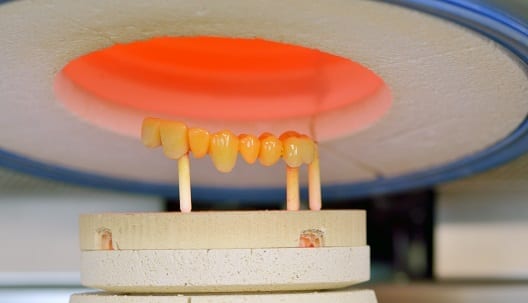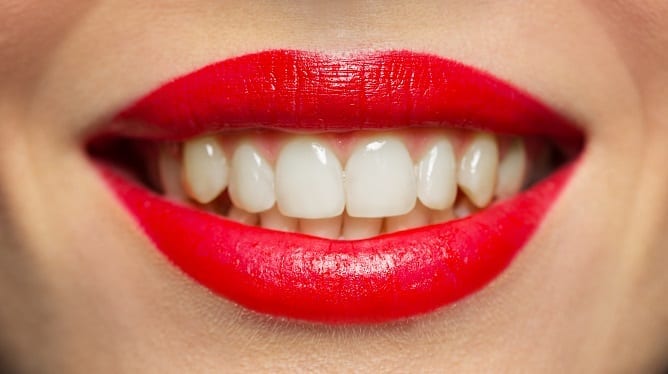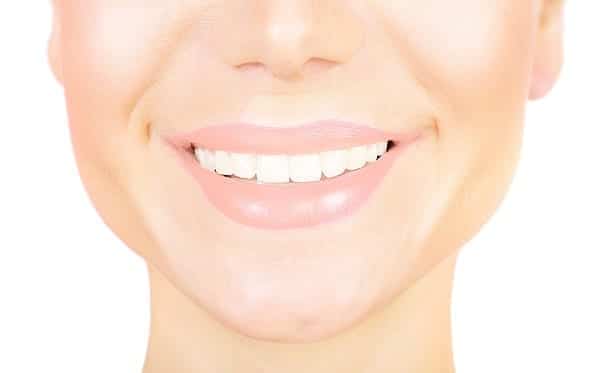If you wish to significantly improve the aesthetics of your teeth without necessarily extracting all of them and then replacing them with crowns and bridges, then veneers is a less drastic way to go about things. You can get that winning celebrity smile you’ve always wanted and longed for without paying too much of a fortune for them. This cosmetic dentistry service typically involves you picking which veneer type works best for you.
The most commonly used materials in fabricating veneers are porcelain and composite resin as well as ceramic. When used by a veteran cosmetic dentist, any of these three materials can beautify your smile and turn it into a megawatt grin worthy of a superstar. With that said, which type of veneer is right for you?
Page Contents
Porcelain Veneers

Even though ceramic and composite resin veneers come with a number of features and benefits, they can’t compete with porcelain in the area of durability. Perhaps ceramic could, but that’s actually interchangeable with porcelain in terms of toughness, with ceramic perhaps being a bit more customizable than either porcelain or composite. At any rate, true porcelain veneers are made of 100 percent porcelain and require contouring of the teeth they’re supposed to aesthetically approve before they could be glued unto them.
- Durability and Toughness: Even though composite resin technology has improved leaps and bounds since the 1980s, the fact remains that porcelain is the stronger material of the two. Porcelain veneers that are maintained well through regular dental hygiene can last from 10 to 15 years or even a lifetime. This is in comparison to the shorter 5 to 7 years of lifespan for composites or resin veneers. On the plus side, resin is cheaper to allow for easier reapplication. They might not be as tough as crowns but they approach that toughness even when front teeth don’t require that much hardness.
- Price and Prep Work: Composite resin cost half as much as porcelain while ceramic or ceramic porcelain cost almost as much. The benefit of ceramic is that it combines the best of two worlds in terms of toughness and cost-effectiveness. Resin veneers last half as long as porcelain to match their value. Most of the cost associated with porcelain veneers are linked to prep work rather than from the material itself. Ceramic is more custom-fit and requires less preparation than either resin or porcelain.
- Aesthetics and The Natural Look: There’s no doubting the aesthetics of porcelain veneers. Porcelain naturally looks like healthy teeth when shaped into veneers. They’re tooth-like without even trying, as opposed to composite resin and ceramic veneers that require dental labs to shape and color them into prosthetic teeth shells. In particular, natural teeth have a translucent quality to them that porcelain is able to replicate, right down to their shell-like toughness. They put the pearl in pearly whites, in short.
- Stain and Damage Resistance: This material is also stain-resistant and chip-resistant to boot due to its strength and hardiness. They’re especially resilient or even impervious to staining from the rigors of eating food after glaze is applied to them after treatment, thus giving them a shiny and glossy look when the procedure is over. This is in contrast to composite resin veneers. Resin material is more porous or absorbent, thus it’s easier for it to stain or retain the color of whatever it is you eat. The color then sticks to the veneer easier, thus necessitating more cleaning effort on your part.
- No Need for Polishing and Diet Adjustments: You don’t need to adjust your diet to avoid stains on your porcelain veneers. This isn’t the case with resin veneers. You also need to get your dentist to polish your composite veneers more in order to get that porcelain shine or toothy aesthetic. Porcelain, even without the glaze, naturally looks toothy or has the appearance of pearly white, healthy teeth from the beginning. It takes a bit more effort and literal polish to get that natural tooth color and look from a composite resin veneer. Even after polishing, resin can’t compare to porcelain veneer quality.
- Longer Wait Times and Natural Tooth Preparation: Even though porcelain veneers don’t need as much adjustments and polishing as ceramic or resin veneers, the natural teeth they’re supposed to cover up do. A lot of preparatory work and contouring is involved in the porcelain veneer procedure. You might even need to wear temporary veneers while you want for the porcelain ones to be properly sculpted in the lab. This requires milling of porcelain material instead of the 3D printing of veneers and crowns with digital accuracy. Chair-side CAD/CAM technologies are now available to speed up the process though for on-site fabrication.
Ceramic Veneers

What about ceramic veneers? What makes them different from their composite resin and porcelain counterparts? Ceramic veneers – like ceramic crowns, bridges, and implants – make use of teeth-colored ceramic materials like zirconia that are bio-inert and resistant to bacterial infection. They’re less likely to accumulate plaque and bacteria and they resist irritating your gums or neighboring natural teeth. They can also be synthesized to be any color, including getting a porcelain-like gleam to them.
- A Permanent Aesthetic Solution: Like with its fellow resin and porcelain counterparts, ceramic veneers shield the front face of the teeth and are cemented unto them in order to permanently change and improve the image of misshapen, broken, or chipped teeth. They can also reinforce or bolster the structural integrity of a worn down, damaged tooth or set of teeth. How it goes about this is what separates it from resin and porcelain. It has the properties of both in terms of durability and cost-effectiveness.
- Synthesized Instead of Milled: Ceramic teeth are synthesized instead of milled, thus minimizing the need for prep time and contouring of your underlying natural teeth to allow the perfect cementing of these veneers unto your original teeth. Dental prints by either a mold or a digital dental scan will be taken. From there, a plaster or CAD model of the teeth is made. This model assists the dental lab technician in making the final veneers or to make a wax-up. The wax-up will be used to synthesize the ceramic veneers and do final touchups on them.
- Wax-Ups versus Final Veneers: If the digital scan is accurate enough the resulting final veneers can be synthesized immediately if required, particularly for chair-side or same-day veneer operations. However, some dental labs opt to put up a wax-up first as a model that shows the final form of the veneers then making adjustments to it thusly. It can be used as a mock-up for the sake of putting in provisional facets that the patient will wear while the ceramic veneers are made.
- Choosing the Color: You can actually choose the color of the veneer. Or rather, your dentist will in light of your dental whiteness preferences. In other words, the final hue of ceramic veneers is determined by the recommendations of the dentist and the requirements of the patient. If you desire getting whiter teeth, the doctor will take that into account. Your skin tone and the color of the neighboring will also be considered so that the final veneers won’t look unnatural or out-of-place when push comes to shove.
- Minimal Teeth Preparation: The main claim to fame of ceramic veneers is the fact that minimal enamel sacrifice is required to cement them firmly unto your old teeth’s surface. The teeth prep depends on the method of preparation, the tooth position, the type of facet used, and the technology available (traditional milling versus CAD/CAM technology). Anesthesia might or might not be required depending on whether the gums and teeth will be affected or not. It depends on how much enamel must be removed.
- The Best of Both Worlds: The ceramic veneer is more customizable than the milled porcelain veneer. It’s as tough as porcelain though, such that the same material has been used in implant dentistry. This means that even though it’s more expensive than composite resin, it’s still tougher and more cost-effective when push comes to shove. It showcases the best of both worlds in terms of the customizable cost-effectiveness of resin and the toughness and aesthetic pleasantness of porcelain.
Resin Veneers

Composite resin material isn’t just material used for tooth fillings. They can also be used for veneers. They’re infamously less durable than their porcelain and ceramic counterparts. They’re also more porous than either of those two materials, making them more vulnerable to staining. However, a direct resin restoration remains an option for many out there because it works good enough for the 5 to 7 years the veneer lasts on average.
- Price or Affordability: Affordability or cost is the main advantage composite resin veneers have over porcelain and even ceramic veneers. On average, porcelain veneers cost twice as much as resins. Pricing is a vital consideration for many people, since their dental insurance usually has minimal or no coverage for this ultimately aesthetic or cosmetic dental procedure. You will be paying out-of-pocket for each veneer, so if you can’t afford even one porcelain veneer then the next best thing is to get resin veneers that cost $250 to $1,000 per tooth.
- Material Selection: Selecting the right kind of composite resin material requires you to answer several questions. Is the restoration located on the aesthetic zone of your smile or the posterior segment of your teeth? Moreover, will the restoration replace part of or all the facial surface of the tooth or teeth? Your doctor should understand the properties of the materials he’ll use relative to the unique circumstances or state of the teeth you wish to improve or reinforce. This way, he has a handle on which composite resin type has the best amount of polishability, opacity, strength, and handling.
- Microfills: This resin type has been around for about 30 to 40 years. They contain about 35 to 50 percent silicon dioxide filler particles that range from 0.02 µm (micrometer) to 0.04 µm. Because of the smallness of its filler size, they can mimic the luster of enamel with nearly the excellence that porcelain brings after they’ve been thoroughly polished. However, whatever it is that they can gain in terms of aesthetics they could lose in overall strength, like sharpening the graphite of a pencil so much that the tip can easily break. It’s more suitable for Class V cervical restorations and anterior restorations.
- Hybrids: Hybrids are composite resins that offer reasonable polishability mixed with impressive strength for non-porcelain or non-ceramic materials. It’s the most frequently used type of veneer for posterior restorations, where the bite forces are much stronger and could grind ordinary front-teeth veneers apart. Its filler particles have sizes ranging from 0.04 µm to 5.00 µm. Also, about 70 to 80 percent of the weight of this resin is made up of those heterogeneous aggregate of filler particles. It’s known for its multiple shades and opacities as well as its inability to retain gloss over time compared to microfills.
- Nanofills and Nanohybrids: Resins have advanced to the point of using “nano technology” in the form of nanofills and nanohybrids. This newest category of composite resins for veneers has been added to the armamentarium composite. It consists of 5 nm (nanometer) to 75 nm “nanomer” particles and 0.6 µm to 1.4 µm “nanocluster” agglomerates as the resin’s fillers. Similar to microfills, these nanofills can be polished to appear like porcelain or real dental enamel. Moreover, the glossiness of a polished nanofill resin veneer can be retained for a much longer time period when compared to older composite formulations like microfills and hybrids.
The Verdict

Porcelain veneers are your best bet for best quality in terms of glossy aesthetics and functional durability of 10-15 years. It really is the non-biological equivalent of healthy, polished teeth. A close second for your veneer material options is the ceramic veneer or ceramic porcelain (synthetic porcelain-like ceramic). They’re known for their porcelain-like aesthetics and bio-inert strength that won’t harm your gums or cause staining like composite resin. The third option isn’t necessarily the least one either. Although resin veneers are known to only last 5-7 years, advancements like nanofills have made them comparatively stronger than before, making them worthwhile alternatives to the super expensive choices of porcelain and ceramic veneers.
Thantakit International Dental Center is Thailand’s longest established dental center. Situated in Bangkok, our clinic is renowned across the world as a destination for world-class dentistry, with most of our patients flying to us from Australia.
Please contact us today and get a FREE dental consultation












